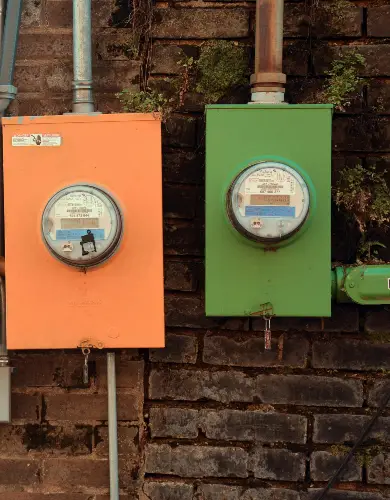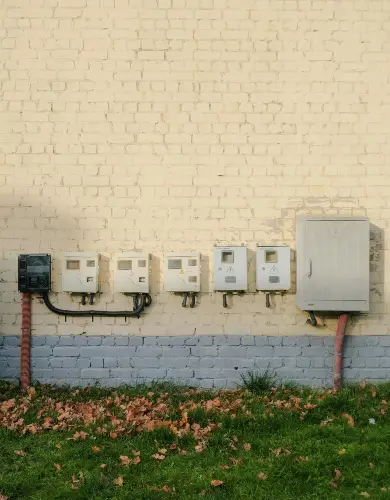A business guide to half-hourly electricity meters
If your business uses a significant amount of electricity, there’s a good chance you already have a half-hourly electricity meter.
These smart-enabled meters automatically record energy usage every 30 minutes. They support higher power demand, offer more advanced data services, and carry regulatory obligations that can increase standing charges.
In this article, our experts explain the key aspects of half-hourly electricity meters, including:
- What is a half-hourly electricity meter?
- How half-hourly meters work
- Are half-hourly meters more expensive?
- Benefits of half-hourly meters
- Who needs a half-hourly meter?
What is a half-hourly electricity meter?
A half-hourly electricity meter is a type of meter that records your power usage every 30 minutes and automatically sends this data to your energy supplier.
Half-hourly meters are typically installed at energy-intensive commercial properties, providing accurate, real-time monitoring of consumption.
These meters are designed to comply with an industry regulation that requires all properties with a peak demand exceeding 100kW to transmit readings every 30 minutes.
What makes it different from a standard electricity meter?
Half-hourly meters use the same technology as a typical electricity meter, except they are digital, automated, and communicate their readings remotely at 30-minute intervals.
Modern smart business energy meters use the same technology as half-hourly meters, but the reporting interval depends on how your supplier has configured the meters.
💡 In July 2027, the Market-wide Half-Hourly Settlement reform will require all domestic and non-domestic smart meters to transmit their readings every 30 minutes.
How half-hourly meters work
These are the three key stages in the operation of a half-hourly meter.
1. Measuring power consumption
A half-hourly meter is installed at the point where the incoming electricity supply connects to a commercial property.
The meter measures two aspects of power:
- Total active energy consumption in kWh, by monitoring voltage and current on the incoming supply.
- Reactive (non-working) energy consumption in kVA.
The meter uses a timestamp to log these two measurements every thirty minutes in its internal memory. It also records the peak half-hourly demand in kW, along with a timestamp for when the peak occurred.
2. Communication of readings
Half-hourly meters are fitted with a communication module that allows them to transmit data via one of the following methods:
- A 3G or 4G mobile network
- The local area network via Wi-Fi
- A landline
The meter automatically transmits 48 time-stamped consumption readings per day. Here’s an example of the format of this data:
2025-07-25 13:00–13:30 → 18.6 kWh
2025-07-25 13:30–14:00 → 19.2 kWh
3. Data transmission
The data transmitted by a half-hourly meter is received and processed by the following data services organisations:
- Data Collector (DC): Gathers raw data from the meter.
- Data Aggregator (DA): Validates and aggregates the data for the supplier.
The processed data is then sent to your supplier to calculate electricity bills.
It is also shared with the wholesale electricity market operator, Elexon, who matches power generation and consumption on the grid.
Are half-hourly meters more expensive?
Yes, business electricity prices for properties with half-hourly meters are typically higher compared to those with standard commercial electricity meters.
This section explains how half-hourly meters impact your electricity charges.
💡 As with other meter types, businesses with half-hourly meters can minimise charges by regularly switching business energy suppliers to get the best deal.
Standing charges
Most business energy tariff include a business electricity standing charge, priced in pence per day, paid daily regardless of consumption.
The largest component of standing charges relates to the fees your supplier pays for distributing electricity through national and local grids, known as TNUoS and DUoS charges.
These fixed distribution charges are calculated in proportion to the Maximum Import Capacity (kVA) of an individual connection to the grid, as this fairly reflects the strain each connection places on the network.
The connection to a household or small commercial property is typically around 8 kVA, whereas a property with a half-hourly meter is typically 100 kVA or more. Accordingly, daily standing charges for businesses with half-hourly meters are usually much higher.
💡kVA is a measure of total apparent power, which approximately equals real power, in kW for most electricity connections.
Unit rates
Having a half-hourly meter doesn’t usually increase your unit rate. In fact, due to the higher volume of energy consumption, unit rates per kWh on a half-hourly meter can be slightly cheaper than those available to an equivalent small business energy customer.
Compare business electricity prices today by requesting bespoke half-hourly meter quotes for your business using our free, no-obligation service.
Demand charges
Businesses with half-hourly meters typically pay a separate monthly capacity charge to their energy supplier. This charge guarantees the availability of the Maximum Import Capacity on their grid connection and is applied as a fixed monthly cost per kVA of capacity.
Additionally, if the Maximum Import Capacity is exceeded during any billing period, these businesses must pay an excess capacity charge.
For more information on these charges, refer to our guide on maximum demand charges.
Reactive power charges
Half-hourly business electricity meters measure the reactive power demand of energy-intensive properties.
Reactive power is a form of non-working power required by equipment such as lifts, escalators, and air conditioning units.
When reactive power exceeds 5% of total power consumption, local grid operators may apply a reactive power charge.
For more information, read our guide to reactive power charges.
Meter operator charges
Businesses with half-hourly meters pay a Meter Operator (MOP) charge to the company responsible for installing and maintaining the meter. Annual MOP charges typically range from £300 to £600.
These charges are either included in your monthly business electricity bill or billed directly by the meter operator.
Who needs a half-hourly meter?
Ofgem regulations require that businesses with a maximum power demand exceeding 100 kW in any half-hour period must have a half-hourly meter.
💡 100 kW is roughly equivalent to the power demand of 25–30 homes during peak electricity usage (when lights, fridges, TVs, kettles, etc. are all on).
You can tell if you already have a half-hourly meter by checking the first two digits of your MPAN:
- Profile class 00: Highly energy-intensive commercial properties.
- Profile class 05–08: Other energy-intensive commercial properties required to have a half-hourly meter since April 2017.
Should I upgrade to a half-hourly meter?
We do not recommend upgrading to a half-hourly meter unless you are required to have one.
Modern smart business energy meters used by small businesses can also provide automatic meter readings every 30 minutes, but typically come with lower standing charges.
Find out more in our guide to business electricity meter installations.
Should I remove my half-hourly meter?
If you’ve recently moved into a commercial property with a half-hourly meter but only have low power demand, it may be beneficial to remove the meter and reduce the import capacity of your business electricity connection.
However, replacing a half-hourly meter and the associated high-capacity wiring can be expensive. Your local distribution network operator will need to carry out this work.
Benefits of half-hourly meters
Half-hourly meters typically cost more, but they come with three clear benefits for businesses.
Accurate billing
By using a half-hourly meter, your business energy supplier receives automatic meter readings, allowing them to accurately track your electricity consumption and bill you each month.
Accurate monthly electricity bills make it easier to monitor your costs and avoid nasty surprises when you submit a manual meter reading.
Off-peak tariffs
Half-hourly meters give your business access to a broader range of business energy contracts.
Suppliers such as Octopus Business Energy offer smart multi-rate tariffs, allowing businesses to take advantage of lower off-peak electricity rates.
For more information, read our guide on multi-rate business energy meters.
Energy consumption data insights
Half-hourly meters automatically provide live data on your business energy consumption.
Combining half-hourly meter data with business energy monitoring software enables you to report, forecast, and optimise your energy usage.
Demand flexibility incentives
Having a half-hourly meter installed allows your business to participate in the Demand Flexibility Service, enabling you to receive payments from the grid operator for reducing consumption during periods of peak demand.
In 2024/25, participants in the Demand Flexibility Service received over £900,000 for reducing demand.
Find out more in our guide to the Demand Flexibility Service.
Who is responsible for my half-hourly meter?
There is often confusion around half-hourly meters due to the various parties involved in their installation, maintenance, and operation. Here’s a summary of the different roles:
Meter Operators
Meter Operators (MOPs) are companies responsible for installing and maintaining half-hourly meters.
After the initial installation, a MOP will carry out regular maintenance to ensure your meter continues to measure consumption and transmit readings accurately.
Find out more in our guide to Meter Operators for business energy customers.
Data Collector
The Data Collector (DC) is a licensed and accredited party responsible for retrieving, validating, and processing half-hourly consumption data from your electricity meter.
The DC uses remote communications (4G, business broadband, etc.) to download this data from your meter.
They ensure that the data produced by your half-hourly meter is accurate and in a format that your supplier can use.
Data Aggregator
The Data Aggregator (DA) is responsible for combining, validating, and preparing half-hourly usage data from multiple sites for submission into the grid’s electricity settlement system and for delivery to individual suppliers.
The DA receives data from the Data Collector and then groups it by supplier or region.
Business electricity suppliers
Your business electricity supplier receives data from the DA and uses it to generate your electricity bills.
The best business energy suppliers, such as British Gas and SSE Business Energy, act as Meter Operators, Data Collectors, and Data Aggregators to provide end-to-end half-hourly meter services to their customers.

